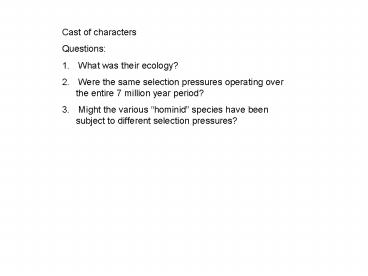Cast of characters - PowerPoint PPT Presentation
1 / 33
Title:
Cast of characters
Description:
Flat face and heavy brow ridges characteristic of much later 'hominids. ... Broad flat (non-prognathus) face. Small molars (not like contemporary ... – PowerPoint PPT presentation
Number of Views:33
Avg rating:3.0/5.0
Title: Cast of characters
1
- Cast of characters
- Questions
- What was their ecology?
- Were the same selection pressures operating over
the entire 7 million year period? - Might the various hominid species have been
subject to different selection pressures?
2
- Cast of characters
- We might usefully think about adaptive grades
- Pre Australopithecus forms
- Australopithecines
Australopithecus
Paranthropus - Homo
3
Figure 11.03
4
Sahelanthropus tchadensis. 6.0 to 7.0 mya Chad.
Skull deformed. Flat face and heavy brow ridges
characteristic of much later hominids. Bipedal
(?) anterior magnum. Reduced canines,
non-functional CP3 Small brain (320 to 350cc).
U-shaped dental arcade.
Intermediate enamel thickness. Nuchal
region suggests a quadruped. Light forest near a
lakeshore.
5
Orrorin tugenensis. 6.0 mya Kenya Femur (thigh
bone) suggests bipedality.
Thick molar enamel.
Chimp-like incisors, canines and
premolars. Associated fossils suggest a mixed
forest/woodland habitat.
6
Ardipithecus ramidus 4.4mya Ardipithecus kadabba
5.8-5.2mya Ethiopia. Bipedal (?) anterior foramen
magnum, some post-cranial remains.
Smaller canines than non hominid apes lacks
CP3 Intermediate
molar enamel. Relatively small
molars. Dense forest environment.
7
Kenyanthropus platyops 3.5 mya, Kenya. Skull
deformed. Biped.
Broad flat (non-prognathus) face.
Small molars (not like contemporary
Australopithecus) diet? Enamel
thickness unknown.
Small brain.
8
Australopithecus spp. 4.2 to 1.0 mya much of E.
and S. Africa Diverse taxon approx. 10
species. Open country, often near water. Quite
sexually dimorphic. Males 50 taller (modern
humans 7) Bipedal but some may have also climbed
extensively.
9
Figure 11.22
10
Figure 11.24
11
Figure 11.25
12
Australopithecus spp. (group 1) A. anamensis
4.2 to 3.8 mya A. afarensis 3.8 to 2.8 mya A.
africanus 3.0 to 2.2 mya A. garhi 2.5 mya A.
habilis 2.0 to 1.8 mya A. rudolfensis 2.4 to 1.8
mya
13
Australopithecus spp. (group 2) Paranthropus
aethiopicus 2.5 mya P. boisei 2.2 to 1.2
mya P. robustus 1.8 to 1.0 mya
14
Australopithecus anamensis 4.2 to 3.8 mya about
50 specimens. Large molars, smaller canines,
thick enamel. But unlike later Australopithecus
in shape of dental arcade, shape of ear hole,
chin.
15
Australopithecus afarensis 3.8 to 2.8 mya best
known early hominid Large molars, smaller
canines, thick enamel. Certainly bipedal but has
an number of adaptations for climbing.
16
Figure 11.11
17
Figure 11.13
18
Figure 11.08
19
Figure 11.10a
20
Figure 11.10b
21
Figure 11.10c
22
Australopithecus africanus 3.0 to 2.2 mya S.
African sites only First Australopithecus to be
discovered (1924). Large molars, smaller, less
dimorphic canines, thick enamel. Still shows
chimplike developmental timing.
23
Figure 11.16
24
Australopithecus garhi 2.5 mya E. Africa
only Very large molars, relatively large canines,
thick enamel, sagittal crest, very prognathic
face. But unlike later Australopithecus in shape
of dental arcade, shape of ear hole, chin.
25
Figure 11.18
26
Australopithecus (H.) habilis A.(H.)
rudolfensis 2.4 to 1.7 mya E. Africa only First
large brained species (500 to 750 ccs) Sort out
into two types. Should they be separate
species? Should they be Homo?
27
Figure 11.21
28
Paranthropus aethiopicus 2.5 mya P. robustus
1.8 to 1.0 MYA S. Africa P. boisei 2.1 to 1.2
MYA E. Africa All are hyper robust massive
jaws and molars, quite small incisors and
canines, significant saggital cresting.
29
Figure 11.24
30
Homo ergaster 1.8 mya First associated with
Oldowan tools but after about 1.5 mya associated
with more elaborate (Acheulean) tools. All teeth
smaller that in Australopithecus, but molars
reduced more. Thinner enamel. Cranial capacity
of about 800cc More than a foot taller than
Australopithecus.
31
Homo ergaster 1.8 mya (continued) Slow pattern
of growth and development like modern humans and
unlike Australopithecus Reduced sexual
dimorphism, equivalent to modern humans (less
than 10 compared to 50 in Australopithecus). Not
restricted to Africa. H. ergaster skull from
the Caucuses dated to 1.7 mya (but associated
with Oldowan tools).
32
Figure 13.01
33
Figure 13.03































